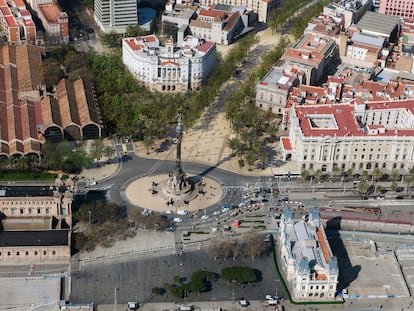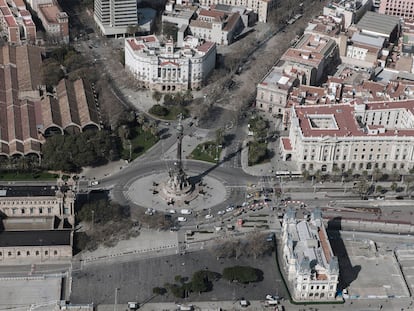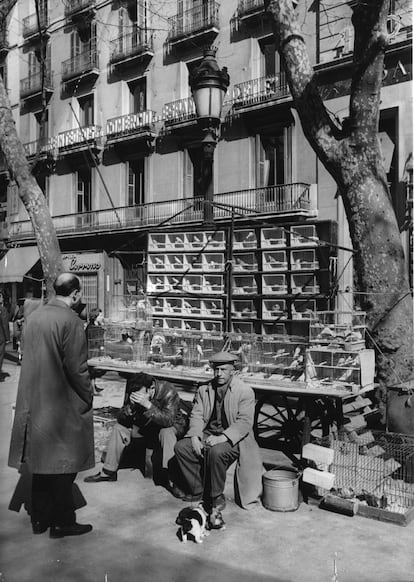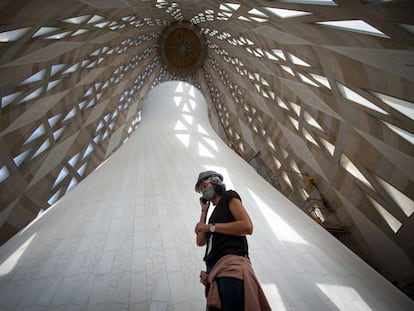‘Tourists also want an authentic city, not a theme park’: The redevelopment plan that seeks to give La Rambla back to Barcelona residents
The project, which is expected to be completed in 2027, seeks to rescue the Catalan capital’s most emblematic promenade from excessive tourism and gentrification. But it seems easier said than done

Whatever happens to La Rambla happens to all of Barcelona. Both the city’s greatness and its misery are concentrated within its three-quarter mile length. What was originally a narrow stream is today, to the unprejudiced eye, a beautiful boulevard dotted with landmark buildings. However, Barcelona residents tend to see it only as an obligatory boundary between the Raval and Gòtic neighborhoods. Only tourists make use of its original function as a promenade that links the central Plaça Catalunya with the old port. “Locals walk along it transversally, and tourists longitudinally,” summarizes the architect Lola Domènec, a member of the cross-disciplinary Km-ZERO team that won the competition for the transformation of La Rambla in 2017. A task that is now finally being resumed and is expected to be completed in 2027.

The redevelopment of the thoroughfare has been going on for a long time, starting two decades ago. Another architect, Itziar González, was a city councilor for the Ciutat Vella district in 2007, when she declared at a news conference that the city should do something about a street that was already taken over by tourism. “Because it was the most universal street in Barcelona, and nobody was doing anything there,” González now recalls. She set out to create an internal committee to study the matter, but her work was interrupted when, after three years, she resigned from her post due to pressure from what she defines as “corrupt practices in the legal and technical services of the district” that clashed with her political action.
The project was taken up again under the Barcelona en Comú government, with Ada Colau as mayor, who in 2017 announced an international competition for the redevelopment. González, by then fully dedicated to her practice as an architect, received a call from the SOS Ramblas neighborhood association, suggesting that she apply. “I live next door, so as a neighbor I said to myself: why not?” she explains. “I set up an interdisciplinary team that we called km-ZERO because we all lived or worked in the area, with Lola Domènec and Olga Tarrassó as authors of the technical part and me in charge of the strategies, as well as other specialists.”
The group was awarded the project and designed 53 actions, all of them agreed upon with different stakeholders. “We involved around 500 people from various groups, including residents and business owners, in that consultative process,” the architects note. In 2018, the preliminary project was presented, and a year later the executive project was ready. But in 2020, with everything ready to be built, the reform was halted, and it was not until the end of Colau’s second term that a dcision was made to resume it. “But it was planned as a five-phase project that would take 10 years, something that seemed out of place to us,” says Lola Domènec. “Fortunately, the [Jaume] Collboni administration has made the decision to do everything in three years, so we will be able to resolve the issue in the short term and without budget increases.”


The first phase, which involves the area around the Columbus monument, next to the port, is already finished. The entire project is expected to be completed in February 2027. By then, the sidewalks will have been widened (up to 5 meters, from the current 3.5 meters) as well as the central promenade, at the cost of reducing the number of lanes for motor vehicles from four to two. The initial idea was to remove it completely, but city officials decided to allow it with restrictions. “I think that La Rambla has to be a space where priority is given to pedestrians, but vehicles must have access to it because it is a complex area with facilities, many bars, restaurants, hotels and shops, as well as housing,” says Domènec. “What we have proposed is that it should be basically pedestrian, but with restricted access for buses and internal users.”
Three new squares will be created, coinciding with the entrance gates of the medieval wall: Portaferrisa, La Boquería and Trencaclaus, with two-coloured paving. The lighting and street furniture will be improved and made more uniform, more space will be given to trees – 375, most of them plane trees – and there are also plans to add cultural facilities (La Fonería, an old forge, will be an immersive art centre, and a second opera centre closer to the sea is being considered to complement the classic Liceu), which would be added to the Teatro Principal, the CCCB, La Virreina, Ars Santa Mònica, the Poliorama, the Academy of Sciences, the Wax Museum or the nearby MACBA. But not everything can be solved with bricks and mortar.

One of the main goals is to rescue the promenade from excess tourism and return it to the citizens. Fernando Casal, a member of the SOS Las Ramblas association, formed by local residents, says: “Tourism is a serious problem that has killed one of the most emblematic streets in the world. It was always full of people, but it used to be very diverse, not the current tourist monoculture.” For his part, Jordi Vallés, a city councilor and local chief of the Economy, Finance and Tourism department, assures that everything is a question of balance: “We want to attract the right type of tourists, and not the other one. It is not about tourists with or without money, but about people with good or bad behaviour. And, as demand is unstoppable, we only have tools to control supply.”
Which seems easier said than done. At present, and with a few exceptions, the shops on La Rambla range from poor-quality restaurants to souvenir shops. “These shops are destroying the image of this street and of the whole city,” says Lola Domènec. “It would be good to reverse this with more local shops. This would even interest tourists, because it is not about driving them out. In fact, tourists also want an authentic city, not a theme park. In the same way that there is social housing, there should be protected premises, with neighborhood shops and local products.” Itziar González adds: “There are options. But some of our measures against gentrification and touristification have not been implemented, because they affect lobbies. There are many empty apartments and vacation rentals. They say there are more than 1,000 people registered as living on this street, but that’s not true: in 2017 there were only about 100. We know this because we checked floor by floor.”

Barcelona’s other big problem, gentrification and the expulsion of the original residents, also finds a privileged setting here. Months ago, the city announced its plan to eliminate tourist housing by 2029, but the architects of the La Rambla project are even more ambitious. “We would have to rescue this street as a space to live in.” Itziar González is more specific: “If you improve a street, it generates capital gains that should be returned to the city. This return could consist of something like, for a number of years, the apartments that are rented out in these buildings must have affordable prices. We included this measure in our plan, but it seems that it is not going to be applied.” Fernando Casal insists: “Until now we have not seen a single gesture to fix the housing problem, which cannot be achieved just by changing the pavement. Fortunately, there are cultural facilities, such as the Liceu, but in general they are institutions that only look out for themselves, without participating much in the life of La Rambla.”
Xavier Masip, manager of another local association, Amics de la Rambla (Friends of la Rambla), which brings together some 300 members, including owners, businesses and institutions, does believe in cultural centres as a transformative element: “Culture will make it more enjoyable for locals and visitors, which is not the case with current stag and hen parties or football fan celebrations,” he says. “We want the redevelopment to also serve for people to make better use of their visit, increasing cultural use. Many people now say that La Rambla is for tourists, that it is not the same as before. Well, we want the new Rambla to be the old Rambla. The one that always existed.”
Sign up for our weekly newsletter to get more English-language news coverage from EL PAÍS USA Edition
Tu suscripción se está usando en otro dispositivo
¿Quieres añadir otro usuario a tu suscripción?
Si continúas leyendo en este dispositivo, no se podrá leer en el otro.
FlechaTu suscripción se está usando en otro dispositivo y solo puedes acceder a EL PAÍS desde un dispositivo a la vez.
Si quieres compartir tu cuenta, cambia tu suscripción a la modalidad Premium, así podrás añadir otro usuario. Cada uno accederá con su propia cuenta de email, lo que os permitirá personalizar vuestra experiencia en EL PAÍS.
¿Tienes una suscripción de empresa? Accede aquí para contratar más cuentas.
En el caso de no saber quién está usando tu cuenta, te recomendamos cambiar tu contraseña aquí.
Si decides continuar compartiendo tu cuenta, este mensaje se mostrará en tu dispositivo y en el de la otra persona que está usando tu cuenta de forma indefinida, afectando a tu experiencia de lectura. Puedes consultar aquí los términos y condiciones de la suscripción digital.
More information
Archived In
Últimas noticias
Most viewed
- Oona Chaplin: ‘I told James Cameron that I was living in a treehouse and starting a permaculture project with a friend’
- Reinhard Genzel, Nobel laureate in physics: ‘One-minute videos will never give you the truth’
- Sinaloa Cartel war is taking its toll on Los Chapitos
- Why the price of coffee has skyrocketed: from Brazilian plantations to specialty coffee houses
- Silver prices are going crazy: This is what’s fueling the rally










































